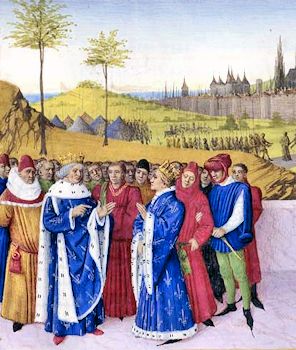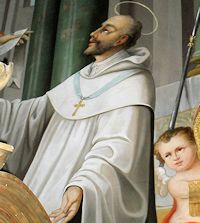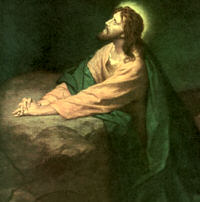Lent: March 28th
Tuesday of the Fourth Week of Lent
Other Commemorations: St. Gontran, King (RM; St. Stephen Harding, Abbot (RM) ; Other Titles: St. Contran or St. Guntramnus or Guntram
» Enjoy our Liturgical Seasons series of e-books!
One man was there who had been ill for thirty-eight years. When Jesus saw him lying there and knew that he had been ill for a long time, he said to him, "Do you want to be well?" The sick man answered him, "Sir, I have no one to put me into the pool when the water is stirred up; while I am on my way, someone else gets down there before me." Jesus said to him, "Rise, take up your mat, and walk." Immediately the man became well, took up his mat, and walked (Jn 5:5-9).
Before the reform of the General Roman Calendar today was the feast of St. John of Capistrano. His feast is now celebrated on October 23.
| The Station today is in St. Lawrence's in Damaso—a church built by Pope St. Damascus in honor of the martyred deacon. It was one of the first parish churches in Rome and was rebuilt in the late 15th century by Bramante, and has since been restored several times. Pope St. Damasus' relics are beneath the altar. Today the church is part of the Cancelleria, or the chancery, and houses the Holy Father's Tribunals: the Roman Rota, Apostolic Signatura, and Apostolic Penitentiary. |  |
Meditation - The Just Man Shall Fall Seven Times
"The just man shall fall seven times, and shall rise again; but the wicked shall fall down into evil" (Prov. 24:16). The characteristic of real wickedness is to fall "down, into evil"-that is, to fall and then consciously and obstinately to remain fallen. Yet, is it not comparative wickedness to fall even into venial sins with such interior dispositions as will not permit the sinner to rise again promptly?
Mark well, the distinguishing trait of the just man is not his absolute freedom from every fall, but rather his entire and quick readiness to rise again-the honest interior disposition which bars out all malice, all settled bad will, and all affection for his wrongdoings; the penitent disposition which will accomplish this so effectually, that his later sins will be committed only in more or less unguarded moments of special weakness or surprise or fickleness, and therefore with only partial freedom and consent of his will. Even so effectually will he guard himself that after a sin, however slight, he will quickly return to his normal virtuousness, acknowledge his guilt, fill his heart and soul with sincere remorse, and then and there long and pray to become more truly humble and less self-reliant, more watchful over himself and quicker in his recourse to God. 0 the shame of your relapses, so many altogether inexcusable! The shame of your repeated relapses, habitual relapses, some perhaps clear evidence of more or less hardness of heart and malice of will! O the shaming thought of the piercing truth: If you had sinned less, Jesus would have suffered less!
Excerpted from Our Way to the Father, Rev. Leo M. Krenz, S.J.
Things to Do:
- If you have not done so already, read the Message of Pope Benedict XVI for Lent of 2006.
- Cook a traditional Lenten recipe to reemphasize this liturgical season in the daily fare of your home. We suggest Split Pea Soup.
St. Gontran or Guntramnus
 St. Gontran was the son of King Clotaire and grandson of Clovis I and Saint Clotildis. When Clotaire died in 561, his domains were divided among his four sons. While Gontran's brother Caribert reigned at Paris, Sigebert in Metz, and Chilperic in Soissons, he was crowned king of Orleans and Burgundy in 561. He then made Chalons-sur-Saone his capital.
St. Gontran was the son of King Clotaire and grandson of Clovis I and Saint Clotildis. When Clotaire died in 561, his domains were divided among his four sons. While Gontran's brother Caribert reigned at Paris, Sigebert in Metz, and Chilperic in Soissons, he was crowned king of Orleans and Burgundy in 561. He then made Chalons-sur-Saone his capital.
When compelled to take up arms against his ambitious brothers and the Lombards, he made no other use of his victories, gained under the conduct of a brave general called Mommol, than to give peace to his dominions. The crimes in which the barbarous habits of his nation involved him, he effaced by tears of repentance. The prosperity of his reign, both in peace and war, condemns those who suppose that human policy cannot be determined by the maxims of the Gospel, whereas the truth is just the contrary: no others can render a government so efficacious and prosperous.
Saint Gontran always treated the pastors of the Church with respect and veneration. He was the protector of the oppressed, and the tender parent of his subjects. He gave the greatest attention to the care of the sick. He fasted, prayed, wept, and offered himself to God night and day as a victim ready to be sacrificed on the altar of His justice, to avert His indignation, which Saint Gontran believed he himself provoked and drew down upon his innocent people. He was a severe punisher of crimes in his officers and others, and by many wholesome regulations he restrained the barbarous licentiousness of his troops, but no man was ever more ready to forgive offenses against his own person. With royal magnificence, he built and endowed many churches and monasteries.
This good king died on the 23rd of March in 593, in the sixty-eighth year of his age, having reigned thirty-one years.
—Excerpted from Little Pictorial Lives of the Saints, a compilation based on Butler's Lives of the Saints and other sources by John Gilmary Shea (Benziger Brothers: New York, 1894).
Patronage: Divorced people; guardians; repentent murderers
Symbols and Representation: king finding treasure and giving it to the poor; king with three treasure chests, one of which has a globe and cross
Highlights and Things to Do:
- Read more about St. Gontran:
- He was buried in the Church of Saint Marcellus, which he had founded in Chalon. Almost immediately, his subjects proclaimed Gontrand a saint and the Catholic Church celebrates his feast day on 28 March. The Huguenots scattered his ashes in the 16th century. Only his skull remains in the Church of St. Marcellus in a silver case.
- See the print from 1636 in the Met Museum of St. Gontran.
St. Stephen Harding
 Stephen Harding, son of an English noble, was born at Sherborne in Dorsetshire, England, about the middle of the eleventh century. He consecrated himself to the monastic life in the Abbey of Sherbonne in Dorsetshire, where he received his early education. He later studied in Paris and Rome, where he pursued a brilliant course in humanities, philosophy and theology.
Stephen Harding, son of an English noble, was born at Sherborne in Dorsetshire, England, about the middle of the eleventh century. He consecrated himself to the monastic life in the Abbey of Sherbonne in Dorsetshire, where he received his early education. He later studied in Paris and Rome, where he pursued a brilliant course in humanities, philosophy and theology.
After studying in Paris and Rome, he visited the monastery of Molesmes. Impressed by its leaders, Robert of Molesmes and Alberic (who were later canonized), Stephen joined the community.
After a few years, the three men, along with another 20 monks, established a more austere monastery in Citeaux. Eventually, Robert was recalled to Molesme (1099), Alberic died (1110), and Stephen was elected abbot.
Stephen Harding is credited with writing the famous Carta Caritatis (Charter of Charity—often referred to as the Charter of Love). It was a six page constitution which laid out the relationship between the Cistercian houses and their abbots, set out the obligations and duties inherent in these, and ensured the accountability of all the abbots and houses to the underlying themes of charity and living according to the rule of Benedict.
Since the monastery received very few novices, he began to have doubts that the new institution was pleasing to God. He prayed for enlightenment and received a response that encouraged him and his small community. From Bourgogne a noble youth arrived with 30 companions, asking to be admitted to the abbey. This noble was the future St. Bernard. In 1115 St. Stephen built the abbey of Clairvaux, and installed St. Bernard as its Abbot. From it 800 abbeys were born.
In 1133, Stephen resigned as the head of the order, due to age and disability, and died the following year.
—Excerpted from Catholic Fire
Highlights and Things to Do:
- Read more about St. Stephen Harding at EWTN.
- Read Carta Caritatis.
- Learn more about the Cistercians.






